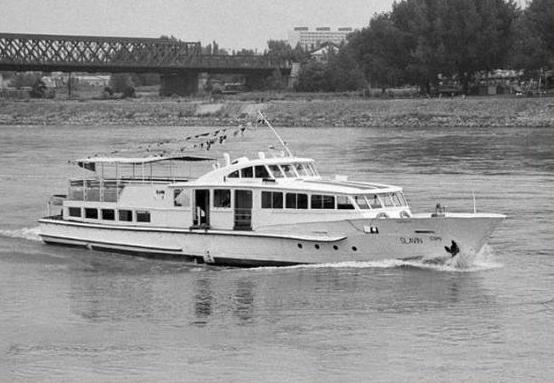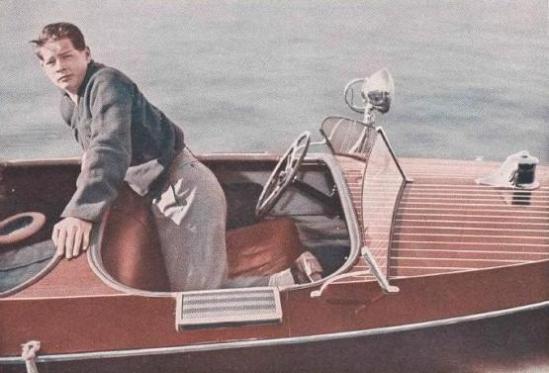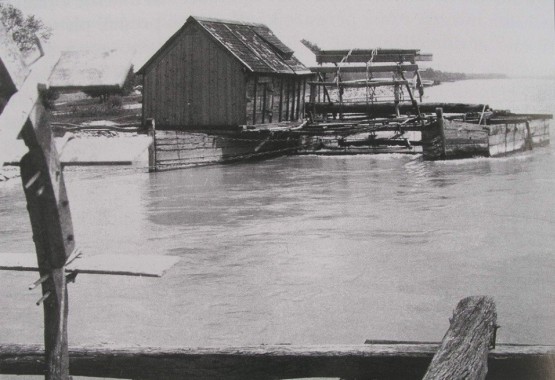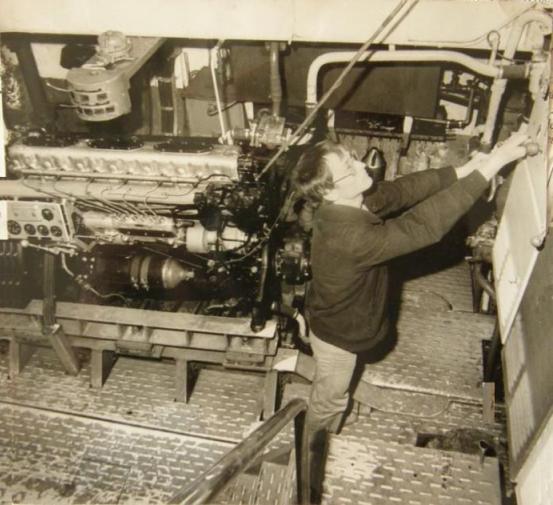Lipovans - Lipoveni

The Lipovan Orthodox Old-Rite Church (or Old-Ritualist Church, Orhodox Old-Rite Church) is Mother of Belokrinitskaya Hierarchy (Estern Orthodox Church) with Jurisdiction all over the world. The head of the Church carries the tittle of Metropolitan of Belo-Krinitsa and All Old Orthodox Christians. His see is in Bila Krynytsya, his residence in Braila, Romania, (current titular : Metropolitan Leonty sice 24 October 1996). Lipovans are Russian Old Believers Russian fled Russia in the late XVII early XVIII century in order to escape the persecution faith. The first part of their name derives from an early church leader, (English form) Philip.

In the company ČSPD fastest motor cargo vessel in navigation DNL Kysuca full force on the free flow of the Danube port of Bratislava.
_____normal_ked_este_chodili_kolesaky.40715_213647_23.jpg)
Upstream to the Upper Danube bridge to bear on the Danube river km 1806.35 with three boats to tug tank slepsal managed to swim only the strongest steam tugs ČSPD Liptov and ČSPD Orava, but most were deployed in cataract surgery. And the images can be seen as a carefully kept crews Danube shipping companies ČSPD N.C. already older towing tank vessels of type VT.

Organisation:
Four eparchies in Romania: 1.Eparchy of Braila and Tulcea 2.Eparchy of Slava 3.Eparchy of Bukovina and Moldava 4.Eparchy of North America, Western Europe, Australia, and Georgia of the former Soviet Union.
The Lipovan Orthodox Old-Rite Church (or Old-Ritualist Church, Orhodox Old-Rite Church) is Mother of Belokrinitskaya Hierarchy (Estern Orthodox Church) with Jurisdiction all over the world. The head of the Church carries the tittle of Metropolitan of Belo-Krinitsa and All Old Orthodox Christians. His see is in Bila Krynytsya, his residence in Braila, Romania, (current titular : Metropolitan Leonty sice 24 October 1996).

Modern motorized cargo ship DNL Kysuca Danube shipping company ČSPD national enterprise Bratislava when cruising downstream from the Lower Danube.
Lipovans – Lipovens are Russian of old religions settle in delta Le Delta du Danube of Danube in the round Tulcea already maybe 250 years. Flighted of pursued of russian imperator for his religion. With thoose nation minority received author to often contact with his service minority to Low Danube. In with his knowledges simpled and resistanted poeple lives in generation in heavy conditions. Often in interest for speed navigation his boots bundled to flow (for his extra danger principale in bundled) riveres convoys ČSPD. Author, of his young years serviceable and knowledge rower it many mall with big tensions observed. Extra capitol was, when sa bundled to side-whels tug boat directly behind whels case (rot-case), or behind to his danger billows and before pulled boat with steels ropes. Thoose maneuvre was evry mal illustration from bigest courage and brilant mastery. Near this occasion offered with clean russian for sale to boatsmans of ships catch of fishes. Author to have person knowledge, when in sumer year 1990 near navigation direct Borcea canal in Romania fall Lipovan fisherman from push sekction push boat ČSPD TR Inovec to Danube after his epileptic paroxysm. His colleague sey only ,,away - pašol “. Boatmans of ship Inovec his look for a to, but without success. Already resulted only charge for leader of convoy registrate thoose sorow-fully event in nearest port. Lipovans was respected in river Danube of most knowledges and most hardness captains without regards to state pertinence.
King Carol II of Romania and his son Crown Prince Michael I in Hotin castle on the river Dniester, in the year 1935.
In Prague received 28.10.1936 King Carol II. during a state visit by President Dr. E. Benes gift special car Skoda with unbreakable glass and by the Director General of the company Ringhoffer-Tatra a.c. Hanuš Rinhhoffer Twelve cylinder Tatra 80th

Passenger ship ČSPD Slavín, his time certainly the most elegant ship on the Danube for navigation in 1982 with the author in the wheelhouse. Length 30.83 m, width 6.47 m, draft 1.31 m, max. 220 number of passengers. Had to recall seven years into its shutdown with a valid vessel certificate. Allegedly sold to 70,000 crowns. The boat was quality all-aluminum construction with a riveted hull and keel. It was designed for the marine lake and short sea shipping.
Zbrojovka Brno a.c. 30.10.1936 gave the prince Michael I. latest car, four-cylinder two-stroke Z-5 Express convertible and Land Slovak in Bratislava 01.11.1936 motorboat. King Carol II. Land Slovak gave in memory of the visit of Slovakia a silver box with a golden state coat of arms and in her gold coins Czechoslovakia excavation. Grand Duke Michael I. obdržal from the Land Committee riding whip with a gold handle and Bratislava City donated noble hosts three publications about the city, splendidly bound, his silver medal, silver plates, old travel clocks, leather-wrapped box and in it photos of prominent urban buildings.

Prince Mihai I of Romania. On January 1, 1936, the Slovak Land donated to the Prince Michael I. a motor boat. To King Charles II. the Slovak State donated a silver box with a golden state gold and a gold coin of Czechoslovakian coinage in the reminder of a visit to Slovakia.

The Last term floating mill on Czechoslovak section of the Danube River has experienced author in the sixties years of the 20th century.

Author in the engine passenger ship ČSPD Slavín while sailing between ports Štúrovo and Komárno in 1982. 2x150 Hp engine power. It was built in the shipyard 1962 MHD Vác, which has been designing it for a seaworthy. Cruising speed 24-16 km/h. Slušovice it bought the collective farm, which it sold to continue, reportedly for 500 000 Crowns. Author in 1987 of the saw during a trip to TR ČSPD Inovec in Krems on the dam very similar vessel.

m/s Miskolcs - Dunajváros. The Hungarian motor river-sea cargo ships with a newly installed anti-aircraft gun to be included in the years 1941-1944 in a military convoy on the Azov and Black Seas in favor of the Axis forces fighting against the USSR.

The Košava under the Beograd.

Czechoslovak Cataract Steamship of the ČSPD Liptov on the Danube in river km 954 Oršova on a separate cruise before 1966 for the downstream boats on the Lower Danube.

President Dr. Edvard Beneš and King Carol II. Romanian during the voyage through the Kazány in Iron Gate on the new Danube passenger ship "King Carol II".

Visit of the President Dr. Eduard Beneš in Orsava Accompanied by King Carol II and Crown Prince Michael I on a new passenger ship "Regele Carol II" built in the Romanian shipyard of T.Severin in 1936.

King Carol II of Romania.

Maďarský dôstojník sa fotí 15.03.1939 pri padlom civilnom montérovi fy Škoda. Štrnásteho marca 1939 dorazili zo železničnej stanice Veľká Sevljuš do kasární kombinovanej roty útočnej vozby dva tanky LT vz. 35 (prototyp Škoda 13620 a armádny tank 13903), vracali sa s predvádzania firmou Škoda a.s. v Sovietskom zväze cez Rumunsko s firemnými montérmi. Tank 13903 bol za tým účelom čs. armádou zapožičaný. Dôstojníci roty tanky zabavili a zaradili do stavu. Montéri sa ponúkli, že sa s nimi zapoja do bojov. Oba tanky boli použité v protiútoku na prístupoch do Svaljavy u Fančíkova, kde jeden z nich (13903) zasiahol maďarský protitankový kanón. Dobrovolník vodič, škodovácky montér Antonín Seidl padol. Opustený vyhorelý tank bol ukorisťený protivníkom. Niektoré jednotky Stráže obrany státu brániace tzv. stredný smer sa už nemohli stiahnuť na Slovensko a ustupovali východným smerom, kde sa bránili prápory I/45 a II/45 pešieho pluku 45 (veliteľ pluku bol podplukovník František Václavek) a oddiel III/12 delostreleckého pluku 12. Tieto jednotky ustupovali z Chustu cez Ťačov k hranici s Rumunskom, ktorú tvoril hraničný most cez rieku Tisu.

Exile President Dr. Edward Beneš sent Lt. colonel GS Heliodor Píka to Bucharest as a military envoy for the Balkans. He helped Czechoslovak refugees here. He focused mainly on demobilized soldiers. After a putsch in Romania and a brief arrest he moved to Istambul.

Armoured minelayer OMm 35, moust modern war ship made in fy Škoda, závod Komárno, prevzatá čs. army in october 1938. Second OMm 36-class armoured minelayer, was dokončená after rozpade ČSR in sommer 1939 for Germany. Armoured minelayers mali oceľový trup s plochým dnom, zvýšenou prieďou v ktorej boli kajuty, na zádí boli 2 tunely pre dve vrtule, mali kormidelňu z pancierového šesťmilimetrového plechu. Na nej bola otočná armoured turret s dvoma ťažkými guľometmi vz.37 ZB. Na zádi was depot na dve rady mín zavesených na transportné koľajnice, na které naväzoval pár záďových vykládacích lyžin. Ďalší guľomet vz.37 was v zadnom čele krytu depotu a na zadnej palube. Výstroj doplňovalo vlečné zariadenie, predná kotva na hadej hlave, dva svetlomety, zamlžovacie zariadenie atď. K pohonu slúžili 2 dieslové dvanásťvalcové V motory Sulzer o výkone 2x 450 HP. Po prevzatí armoured minelayers Germany was zaraďené k nemeckej Danube war Flotille, pod označením Flußminenleger FM-l a Flußminenleger FM-II. In the year 1940 was sold to Marina Regală Română kde slúžili pod označením V-5 and V-6. Dĺžka 31 metrov, šírka bez odierky 4,16 metra, bočná výška trupu 1,62 metrov, maximálny ponor 0,92 metra, maximálny výtlak 60 ton, rýchlosť 20 uzlov, posádka 18 mužov, Armament: In Romanian service: 1 x 20 mm Oerlikon AA gun, 6 x 8 mm machine guns (2x2, 2x1), 22 mines vz. 28 or 22x Z vz.32.

Sip canal vo vojnových rokoch 1941-1945, protiprúdna plavba s naloženými tankovými člnmi and predprahom parnými lokomotívami.


In the right Mihail Moruzov, nightmare not only for enemies, the most famous Lipovan, head of SSI of the county Tulcea. Chef Serviciului Special de Informații-SSI. Until his death in 1940 the most important ally 2nd Department of Head staff Czechoslovak army. He was assassinated on 27 November 1940 at Jilava prison after the abdication of King Carol II and on 04.09.1940 when raised in Romania General Ion Antonescu dictatorship.

King Carol II of Romania.
Parents Nicolae and Maria Moruzov, had four brothers and two sisters, of Russian origin, Lipoveni. Simion grandfather was a priest and father served in the Russian Church in Tulcea forty years.

Jilava prison today. Until his arrest on 5 September 1940 at the behest of the dictator Ion Antonescu was Lipovan old beliefs Mihail Moruzov support of King Carol II of Romania. After the forced abdication of King September 6, 1940, he emigrated to Portugal.

Lipovans crew boat through both the sale of fish and at the same time be driven upstream.
_____lippovani_church_of_hirsova.190513_152310_23.jpg)
Church Orthodox Church old rite in the town Hârşova (Harsova) with a port near where they live Lipovans.

Danube dangerous rocky straits Harsova. Prohibition meet the ship. In the spring of 1969 for high water there was a serious accident downstream convoy (which are signed author) boat ČSPD Tábor and opposite convoy tug SPD Riga. Frontally damaged boats ČSPD disaster freely floated downstream and some boats convoy SPD damaged laterally dived. 10025 boat to sail through the trees. To enable navigation in low water level of the Danube was built Borcea canal where boats Strait Harsova circumvented. My mouth on the 375 km, second is next the port of Braila 174 km.

Push barges RO-RO with hydraulic folding ramp were built for ČSPD N.C. in Romanian shipyard to transport truckloads. It was delivered in 1989 as part of debt redemption Romania Czechoslovakia. In Port Pálenisko of Bratislava it was for them, a new position RO-RO. Barges RO-RO should be deployed from the port of Reni to Czechoslovakia, Austria and Germany.

For continuous use on the Lower Danube he was in Bulgaria before 1989, built from state funds of Czechoslovakia floating workshop PD - 1 with a displacement of 1,493 tonnes for the shipping companies to plant RaND ČSPD N.C. Bratislava. It was intended for the repair of its vessels with a greater draft and performance deployed on this stretch of the Danube. Workers floating workshops be rotate in session.

Port of Braila in 1965. Steam port buxer before rebounding to the left to park the loaded cargo boat ČSPD n.p. from beneath the loading of seagoing freighters. Contraflow towed barge is waiting for addition of a boat laden cargo port buxer.

The Lipovans in the Danube Delta.

In the picture from 9. mai 1977 je soviet posádka na korme war ship "ВРД-268", former armoured minelayer OMm 36 from Czechoslovak Danube fleet. Soviet navy sňalo jej turret from 48 mm pancierového plechu with dvomi ťažkými machine gun vz. 37. Bola ako vojnová korisť soviet Danube fleet skonfiškovaná Romanian Royal Navy u ktorého služila ako V 6 spolu so sester armoured minelayer V 5, former OMm 35. Both was in the year 1939 včlenené to Deutsche Krigsmarine ako Flußminenleger FM 2 a Flußminenleger FM 1. Krigsmarine sňala ich depot from 6mm pacierového plechu and nahradila na zadnej palube 1 ťažký machine gun vz. 37 ZB swiss 1 x 20 mm automat canon Oerlikon Contraves. In the year 1940 both ship sold to Romania.

Colleagues of author Navigators (elders) boats with their catches in 1969. The images can be seen as meticulously maintained by them in their Schuten Danube shipping companies ČSPD National business in Bratislava.

Similar tarpaulin fishing boats are still used around the lower stretch of the Danube, that is, Serbia, Bulgaria, Romania and Ukraine.

Beluga sturgeon with valuable icers caught in the Romanian Danube Delta. The author remembers that in 1978 a freshly caught three-meter elevation was placed in the Yugoslavian harbor "Veliko Gradište" in the port yard. She was there for the shipboard ship "Theodor Körner" of DDSG.

Odessa, May 1964 technical employees RaND and future crew in assuming that time Europe\'s most modern passenger speed boats " Raketa " for Personal transport shipping companies ČSPD N.C.

Soldier of the 20th Infantry Regiment from the Slovak 1st Infantry Division in the summer of 1943 he adapted himself in his free time to the domestic traditions of fishing in the Crimea regardless of the state of war.
In the autumn of 1943 in the Axis units fighting on the river Dneper with the Soviet Army was lost the towage steamer "Váh" of the shipping company Slovak Dunajplavba SPD account. comp. 280HP and a capacity of 500t.
Romanian King Mihai I. in August 1944 with the Allied Slovak army armed campaign against the German Reich shortened World War II at least six months, saved hundreds of thousands of lives can be Milonas. Events employees Slovak Dunajplavba SPD a.c. surprised the professional part of the elite since 1924 cooperated with SSI (to 1940 Director son of an Orthodox priest old beliefs Mihail Moruzov, then in March 1945 Director Eugen Cristecsu) and Czechoslovak army secret service (2nd Section GS Chef Lietn. GS. Frantisek Moravec), or Slovak army secret service (2nd Section GS Chef Major infantry Alojz Androvič) even among employees Č.S.D. a.c. The changed situation in Slovakia and Romania responded 5 September 1944 (September 8, 1944 has been declared the cabinet Constantin Muraviev state of war with Germany, Bulgaria) coup Bulgaria (Rapporteur territorial claims of Hungary in the second Vienna Arbitration against Romania), which was finally amended Germany\'s strategic situation in the Balkans and Central Europe, to its detriment. On 15 October 1944 the struggle of Slovak and Romanian army against the Wehrmacht had already been forced to react to the enemy from fighting in 1938-1939 (successful bidder territorial claims in the 1st Vienna Award and 2nd Vienna Award against Romania) regent Miklós Horthy attempt the withdrawal of Hungary from the war. Coup in Hungary and his cast Wehrmacht only limited possibilities warring Slovak Army (1st ČSA), the situation of German troops in the Balkans could change.

Romanian royal crown is made of steel Turkish cannon captured Romanians during the war for independence in the years 1877-1878. The crown is not gilded, which expresses the heroism of Romanian soldiers in the war. Assumes no diamonds and precious stones. They made it to the coronation of the first Romanian king Carol I and the declaration of the Kingdom of 10 May 1881. On 15 October 1922 it was crowned at Alba Iulia nephew king Carol I, Ferdinand I and 6 September 1940 it was crowned Michael I. His father, son, Ferdinand I, Carol II. coronation planned for September 1930. There has been for his relationship with Ms. Magda Lupescu.
Notes:
Sources: Andrej Vrbacký ; " N.W. " November, October 1936 ; cpt. Alexander Oberta ; Peter Simeonov ;



 back
back 


